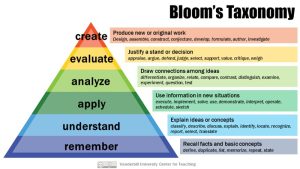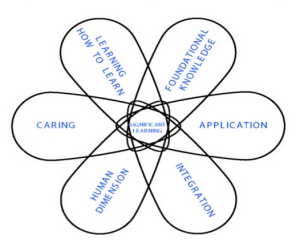21 Learning Taxonomies: Bloom and Fink
Learning taxonomies are structured frameworks that categorize different types of learning and cognitive processes. They help instructors clarify the kinds of knowledge and skills they want students to develop, ensuring alignment between learning outcomes, instruction, and assessment. By using taxonomies as design tools, educators can make more intentional choices about what they teach and how they teach it—supporting deeper, more meaningful learning. Two widely used frameworks are Bloom’s Revised Taxonomy and Fink’s Taxonomy of Significant Learning, each offering a unique lens for thinking about educational goals.
Bloom’s Taxonomy
In 2001, a group of educational psychologists revised the original Bloom’s Taxonomy (1956) to better reflect how people learn. This updated version presents cognitive processes as active verbs, arranged from lower to higher levels of complexity:
-
Remember – Recognize and recall relevant information.
Example: List the parts of a eukaryotic cell (biology); recall key events of the French Revolution (history). -
Understand – Interpret, summarize, or explain ideas.
Example: Summarize the plot of a novel (literature); explain a supply and demand curve (economics). -
Apply – Use knowledge to carry out procedures or solve problems.
Example: Use the quadratic formula to solve problems (mathematics); apply ethical frameworks to case studies (philosophy). -
Analyze – Break down information and examine relationships.
Example: Compare rhetorical strategies in speeches (communication); dissect architectural styles in a building (art history). -
Evaluate – Make judgments based on criteria and standards.
Example: Critique a marketing plan (business); assess the validity of a scientific experiment (chemistry). -
Create – Put elements together to form a novel, coherent whole.
Example: Compose an original piece of music (music); design an experiment to test a hypothesis (psychology).
This taxonomy also includes four types of knowledge—factual, conceptual, procedural, and metacognitive—that help instructors target different aspects of student understanding. Together, the cognitive processes and knowledge types provide a rich structure for developing outcomes, assignments, and assessments.

Why Use Bloom’s Taxonomy?
Bloom’s Taxonomy offers a clear path for designing courses, setting learning goals, and ensuring alignment between objectives, instruction, and assessments. It helps instructors to:
- Clearly define learning objectives.
- Develop targeted instructional activities.
- Create assessments that reflect students’ levels of understanding.
By using Bloom’s Taxonomy, educators can foster structured, meaningful learning experiences that guide students from foundational knowledge toward higher-order thinking and application.
Fink’s Taxonomy of Significant Learning

Fink’s Taxonomy of Significant Learning
Fink’s Taxonomy expands beyond cognitive skills to incorporate affective, interpersonal, and reflective dimensions of learning. It includes six categories:
-
Foundational Knowledge – Understanding essential information and ideas.
Example: Describe key interactions between atmospheric elements (environmental science). -
Application – Using knowledge in practical or creative ways.
Example: Evaluate research studies (public health); perform environmental assessments (geography). -
Integration – Making connections among ideas or experiences.
Example: Synthesize statistical data for informed decisions (sociology); describe how cultural factors influence historical trends (history). -
Human Dimension – Learning about oneself and others.
Example: Reflect on personal biases (psychology); demonstrate respect in team settings (engineering). -
Caring – Developing new feelings, interests, or values.
Example: Advocate for environmental justice (political science); value ongoing engagement with the arts (humanities). -
Learning How to Learn – Becoming a more effective, self-directed learner.
Example: Create a personal learning plan (education); develop metacognitive strategies (any discipline).
Fink’s taxonomy emphasizes the integrated nature of learning—growth in one area often supports development in another. It encourages instructors to consider not just what students know, but also who they become and how they relate to the world and to themselves.
Comparing Fink’s and Bloom’s Taxonomies: Expanding the Scope of Learning
Fink’s Taxonomy of Significant Learning differs from Bloom’s by broadening the types of learning goals to encompass not only cognitive skills but also affective, interpersonal, and lifelong learning competencies. While Bloom’s Taxonomy focuses primarily on cognitive processes like knowledge recall, analysis, and application, Fink’s model integrates the affective and relational dimensions of learning.
In Fink’s Taxonomy, cognitive skills are placed alongside goals related to Caring, the Human Dimension, and Learning How to Learn, thereby framing learning as a more holistic and interconnected process. This approach encourages educators to consider not just what students should know but also who they are becoming and how they connect with others.
Choosing a Taxonomy: Context and Intent
Both Bloom’s Revised Taxonomy and Fink’s Taxonomy offer valuable tools for designing learning experiences. Bloom’s framework is particularly useful for building cognitive complexity and aligning assessments with course outcomes. Fink’s taxonomy offers a broader, more holistic view that encourages instructors to consider emotional, social, and personal dimensions of learning. Depending on your goals and context, you might choose one over the other—or use both in combination.
Throughout this guide, you’ll see these taxonomies applied in practical ways: for writing learning outcomes, designing assessments, facilitating discussion, and more. It is very useful to reference such taxonomies at whatever scale you are working on, whether structuring a single lesson or planning an entire course.
Primary Sources
This section is informed by and adapted from the following sources:
- Intentional College Teaching. Fink’s Taxonomy of Significant Learning.
- Available at: Intentional College Teaching Website
- Armstrong, P. (2010). Bloom’s Taxonomy. Vanderbilt University Center for Teaching.
- Retrieved January 2025 from: Vanderbilt CFT Website
Use of AI in Section Development
This section was developed using a combination of existing research, expert-informed insights, and AI-assisted drafting. ChatGPT (OpenAI) was used to:
- Synthesize and clarify key concepts from Fink’s and Bloom’s Taxonomies into a coherent and accessible framework for instructors.
- Develop practical applications to help instructors design learning experiences that promote deeper understanding and student engagement.
- Ensure readability and flow, aligning learning taxonomies with best practices in curriculum design and instructional planning.
While AI-assisted drafting provided a structured foundation, all final content was reviewed, revised, and contextualized to maintain accuracy, pedagogical effectiveness, and alignment with the cited research. This section remains grounded in scholarly and institutional best practices and respects Creative Commons licensing where applicable.
Media Attributions
- 29428436431_c12484fd8c_c
- fink-flower-logo
